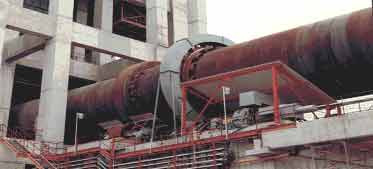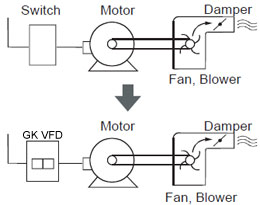Home » Applications » VFD in Cement Industry
VFD in Cement Industry
In cement plants, VFDs provide controlled torque and speed to the kiln, which increases the life of the mechanical system, and reduces maintenance and operating costs. The VFDs also provide feedback signals, which improve cement kiln process control.
Gozuk provides both ac and dc drive technology suitable for cement kiln applications. In the past, dc drives and motors have been the VFD systems of choice for cement kiln industries. With the rapid advance of power semiconductors and ac VFD controls, ac VFDs have gained acceptance for cement kilns in recent years. A tremendous amount of effort has also been put into developing the advanced diagnostic features, which work to greatly reduce downtime and troubleshooting time.

Kiln VFD and Motor Requirements
Gozuk VFDs meet or exceed cement kiln requirements. The most notable motor and VFD features required for cement kilns are listed below:
Controlled Acceleration
The controlled, timed acceleration provided by a VFD is very beneficial for the kiln, compared to starting the kiln motor directly from the AC line. Rapid, across-the-line starting of the kiln motor could result in unwanted torsional oscillations and stresses in parts of the driven machine. For example, a typical kiln could easily be accelerated to top speed in 2 to 3 seconds if the motor were permitted to do so. But the kiln's long cylindrical tube, large reduction gear, and its associated mechanisms would be subjected to excessive stresses and perhaps damage. A precisely controlled, timed kiln acceleration helps extend equipment life, and maintain consistent product output.
Kiln Conditions and Effect on Starting Torques
The starting torques typically required for a normal kiln are 125 to 175% of motor rated torque assuming the following conditions:
Feedback to the Process Control System
A VFD provides a very useful torque or KW feedback signal to help in improving process control of the cement kiln itself. A kiln VFD torque signal provides the earliest warning conditions such as a flush coming through the kiln, a clinker ring beginning to break up within the kiln, or a mechanical problem such as an idler roll bearing developing major friction. Automatic kiln control systems often use a filtered torque signal and its rate of change as part of the logic for controlling the kiln and its operating speed. Therefore, a good noise-free torque signal is critical, and is available in the VFDs.
Gozuk supplies total system solutions for the cement industry, offering experience and capability with VFDs, motors, transformers, control components, PLC's, Human Machine Interfaces, installation, and engineering services.
Gozuk provides both ac and dc drive technology suitable for cement kiln applications. In the past, dc drives and motors have been the VFD systems of choice for cement kiln industries. With the rapid advance of power semiconductors and ac VFD controls, ac VFDs have gained acceptance for cement kilns in recent years. A tremendous amount of effort has also been put into developing the advanced diagnostic features, which work to greatly reduce downtime and troubleshooting time.

Kiln VFD and Motor Requirements
Gozuk VFDs meet or exceed cement kiln requirements. The most notable motor and VFD features required for cement kilns are listed below:
- The VFD has 200 to 250% starting torque for 60 seconds
- Timed acceleration rate, typically 60 seconds from 0 to top speed
- Current limit protection during starting
- Continuous monitoring of motor loading conditions, with an alarm output for any overload
- The VFD has up to 100% continuous operating torque available from 25% to 100% speed
- Outdoor, weather protected motor casings
- Elevated ambient temperature rating, and temperature monitoring detectors
- Motor tachometers, shaft slingers, space heaters, and waterproof conduit boxes
- VFD stall protection
- Ground fault protection
- Controlled operating speed regulation, typically +/- 1/2% of rated speed
- Stopped / running, and OK / Fault indicating contact outputs
- Remote / local testing and adjustment devices
- Provision to follow a 4-20 mA speed signal
- The VFD has analog outputs for speed feedback and motor load feedback to plant process controls
- Advanced diagnostics for quick and easy maintenance and troubleshooting
Controlled Acceleration
The controlled, timed acceleration provided by a VFD is very beneficial for the kiln, compared to starting the kiln motor directly from the AC line. Rapid, across-the-line starting of the kiln motor could result in unwanted torsional oscillations and stresses in parts of the driven machine. For example, a typical kiln could easily be accelerated to top speed in 2 to 3 seconds if the motor were permitted to do so. But the kiln's long cylindrical tube, large reduction gear, and its associated mechanisms would be subjected to excessive stresses and perhaps damage. A precisely controlled, timed kiln acceleration helps extend equipment life, and maintain consistent product output.
Kiln Conditions and Effect on Starting Torques
The starting torques typically required for a normal kiln are 125 to 175% of motor rated torque assuming the following conditions:
- There are no clinker rings
- There are no mud rings
- The idler rolls are properly aligned
- Lubrication is normal for all of the kiln's supporting idler rolls and gear reducing units
- The charge in the kiln is at the minimum elevation (sometimes called the "6 o'clock" position.)
Feedback to the Process Control System
A VFD provides a very useful torque or KW feedback signal to help in improving process control of the cement kiln itself. A kiln VFD torque signal provides the earliest warning conditions such as a flush coming through the kiln, a clinker ring beginning to break up within the kiln, or a mechanical problem such as an idler roll bearing developing major friction. Automatic kiln control systems often use a filtered torque signal and its rate of change as part of the logic for controlling the kiln and its operating speed. Therefore, a good noise-free torque signal is critical, and is available in the VFDs.
Gozuk supplies total system solutions for the cement industry, offering experience and capability with VFDs, motors, transformers, control components, PLC's, Human Machine Interfaces, installation, and engineering services.
what shall be bypass arrangement if VFD for KIln fails?
Post a Comment:
You may also like:
Featured Articles
Variable frequency drive application ...
 Variable Frequency Drive (VFD) can be used in lots of fields. Variable frequency drives are widely used to control the speed of ...
Variable Frequency Drive (VFD) can be used in lots of fields. Variable frequency drives are widely used to control the speed of ...
 Variable Frequency Drive (VFD) can be used in lots of fields. Variable frequency drives are widely used to control the speed of ...
Variable Frequency Drive (VFD) can be used in lots of fields. Variable frequency drives are widely used to control the speed of ...
VFD manufacturers
